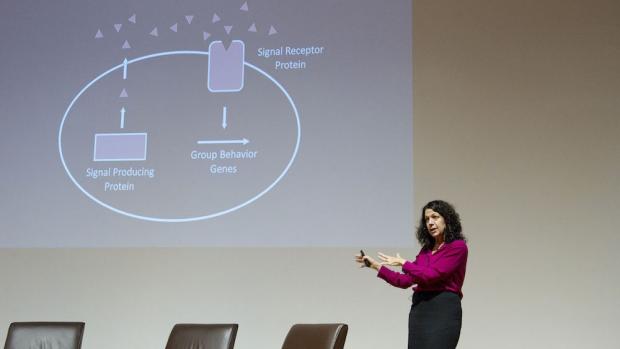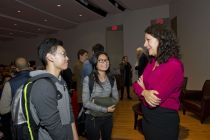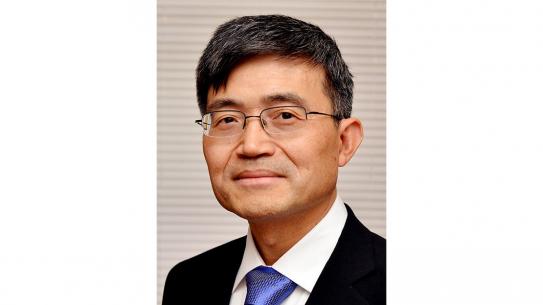Sharing Secrets: How Bacteria Communicate
2016 Lynford Lecture

“We live [now] in the age of bacteria,” Jeffrey Lynford said in his introduction to the 2016 Lynford Lecture. Citing the famous quote from paleontologist Stephen Jay Gould, Lynford, who along with his wife, Tondra, sponsors the annual lecture, reminded the audience that bacteria have thrived for billions of years. Bacteria can commit great crimes, such as pneumonia and the plague, yet they also provide for a healthy human digestive system and a healthy environment. But how do these simple microorganisms, asked the 2016 Lynford lecturer, Bonnie Bassler, “have this enormous impact on this earth?”
The answer, according to Bassler, is that bacteria talk to and work with each other through quorum sensing — bacteria’s communication circuit. Bassler presented her research in her discussion titled “Tiny Conspiracies: Cell-to-Cell Communication in Bacteria.” Bassler is a Professor and Chair of Molecular Biology at Princeton University, a Howard Hughes Medical Institute Investigator, and the 2002 recipient of the MacArthur Foundation Fellowship, commonly known as the “genius grant.” In 2011 she was nominated by President Barack Obama to the National Science Board.
Bacteria: tiny & efficient team players
Bassler spent the first part of the evening discussing how quorum sensing works and its future in medicine. In quorum sensing, a bacterium can “count” fellow bacteria by releasing molecules called autoinducers that seek out and bind to cell receptors. Once the bacteria determine there is an optimal population density of its kind, they can coordinate gene expression to simultaneously release a toxin or emit light.
Bassler first observed quorum sensing in the bioluminescent bacteria Vibrio fischeri, which live in a symbiotic relationship with the Hawaiian bobtail squid. The squid houses and feeds the bacteria, which in turn “hide” the nocturnal animal from predators through “counter-illumination” (the bacteria’s light mimics the amount of light emitted from the moon, thereby negating the squid’s shadow). V.fischeri autoinducers bind only to receptors of other V. fischeri cells, allowing the bacteria to synchronize their bioluminescence. Bassler found that millions of bacteria species have autoinducer molecules with the same chemical foundation, but with species-specific chemical variations that facilitate “lock-and-key” intraspecies communication.
Most bacteria, though, live in a mixed-species environment. In testing bacteria that live in biofilms, Bassler discovered that they not only conduct intraspecies quorum sensing, but they possess secondary quorum sensing. This secondary system produces identical molecules across hundreds of bacteria species that make the bacteria, as Bassler said, “bilingual.” Further research into this inter-species communication can be essential in not just combating “bad” bacteria, but helping make “good” bacteria work even better.
Bassler’s current focus is whether interference with these communication circuits can interfere with virulence — a bacteria’s ability to spread and infect — within many different bacteria species and what that could mean for the medical world. Bassler’s lab created an inhibitor to block quorum sensing in the Pseudomonas pathogen, which runs rampant in hospitals, and found it can stop both the biofilm production and shut down virulence by 90 percent. With this promising discovery, the next steps are determining how to turn these anti-quorum sensing molecules into medicine.
Quorum sensing in other species
Following Bassler’s lecture, Lynford moderated a panel discussion between Bassler; Dr. Martin J. Blaser, Professor of Medicine and of Microbiology at the NYU School of Medicine and the Director of the Human Microbiome Program; and Dr. Daniel Kronauer, Professor at The Rockefeller University and Head of the Laboratory of Insect Social Evolution and Behavior.

Bonnie Bassler (right) chats with students after the lecture
Blaser and Kronauer noted the appearance of quorum sensing and cooperative activity within their own research into the human microbiome and social behaviors of insects, respectively. In Blaser’s exploration into human microbiomes and the effects of antibiotics upon it, quorum sensing seemed “obvious” within diverse environments. The “hundreds of thousands of species” that inhabit a microbiome, though, make quorum sensing harder to study and Blaser’s lab is still solving this problem. Describing a more physical exemplification of quorum sensing, Kronauer discussed the communicative and cooperative systems within ant and bee colonies. Kronauer highlighted the collective decision-making that bees exhibit when choosing a new nest, as well as the honeypot ant species’ ability to distinguish between their colony and another during tournaments of dominance, whereby the colony with the higher ratio ‘wins’ the battle.
Medical and engineering applications of quorum sensing
As the potential medical benefits of quorum sensing buzzed around the audience, Bassler noted that generating medicine out of her research is the “hardest” process. She emphasized more collaborative work between biologists and engineers in creating real-world applications using quorum sensing. “If you could hang anti-quorum sensing molecules off of plastic, you could make … infection-free catheters,” Bassler suggested, noting the current trend of engineering “biologically inspired materials.”
“Where the big breakthroughs come are when disciplines meet up and people go beyond their comfort zone,” Bassler said, listing the biologists, physicists, engineers, material scientists and chemists all working together in her lab. To apply quorum sensing outside of the lab, researchers from all disciplines must first work together on the path towards making medical advancements.
Learn more about the Lynford Lecture Series.
Watch the 2016 Lynford Lecture:
Camila Ryder
Graduate School of Arts and Science
Master of Arts in English Literature, Class of 2018




